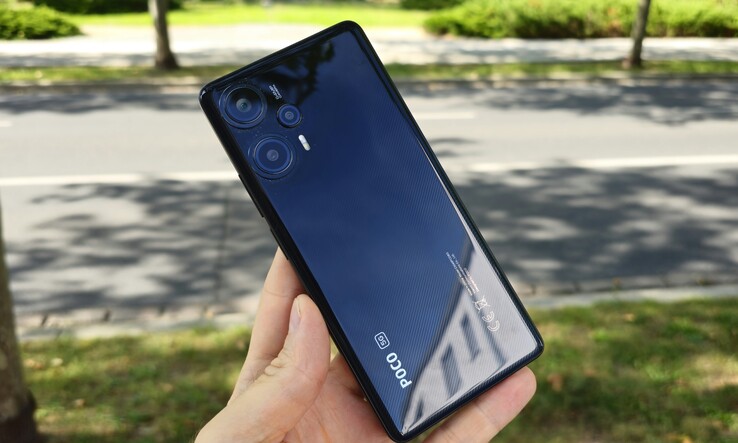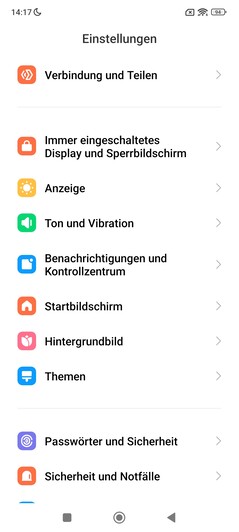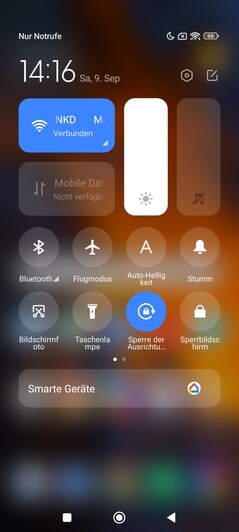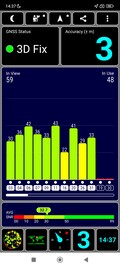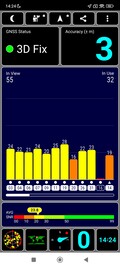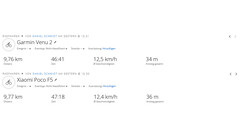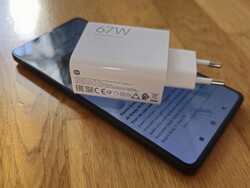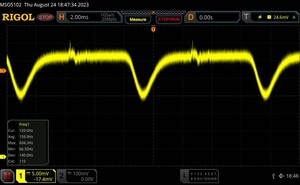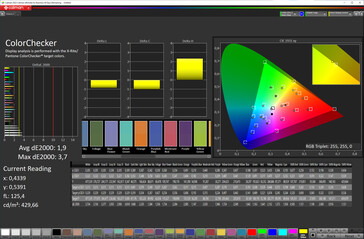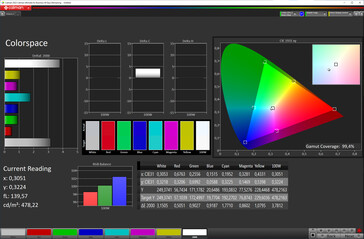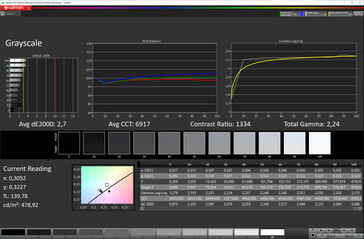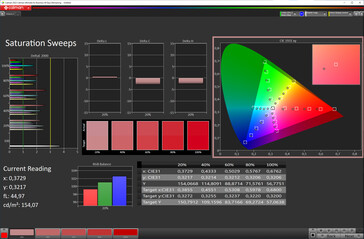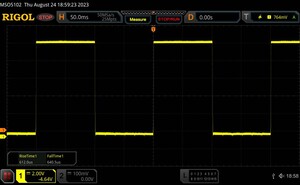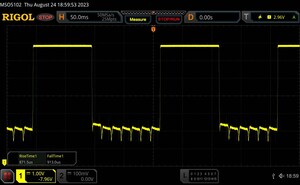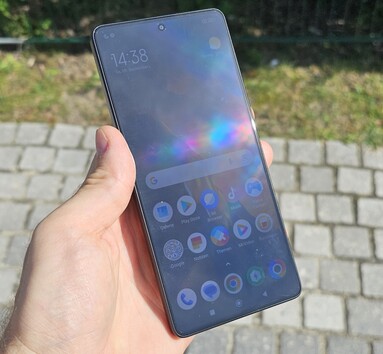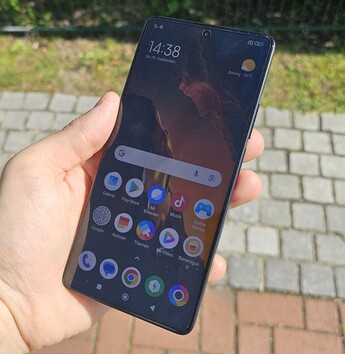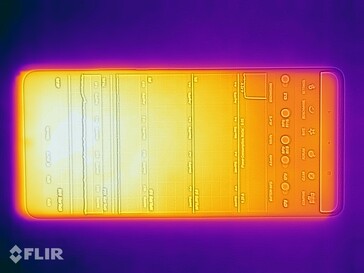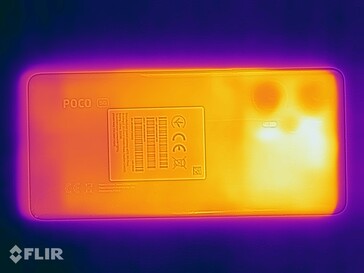Poco F5 smartphone review - The lightweight Xiaomi phone outclasses the competition with its performance [Redmi Note 12 Turbo]
Poco's mid-range F-series phone places speed at the forefront, which is said to be achieved with the help of a super-fast SoC from Qualcomm. The Poco F5 is one of the first smartphones to use the Snapdragon 7+ Gen 2, meaning the Poco phone promises performance levels similar to a Snapdragon 8 Gen 1. The Xiaomi phone, which is marketed as the Redmi Note 12 Turbo internationally, also offers fast storage connection for a mid-range phone with its LPDDR5 and UFS 3.1. You can choose from two storage variants:
Poco F5 (8 GB RAM | 256 GB) | US$460 (MRSP)
Poco F5 (12 GB RAM | 256 GB) | US$492.86 (MRSP).
Aside from this, the Poco phone, which has a 6.67-inch 120 Hz display, features a 64-MP main camera with a 1/2-inch sensor and OIS. Its 5,000 mAh battery is also supposedly charged quite quickly using the proprietary 67-watt charger.
Possible competitors compared
Rating | Date | Model | Weight | Drive | Size | Resolution | Price |
|---|---|---|---|---|---|---|---|
| 86.8 % v7 (old) | 09 / 2023 | Xiaomi Poco F5 SD 7+ Gen 2, Adreno 725 | 181 g | 256 GB UFS 3.1 Flash | 6.67" | 2400x1080 | |
| 86.4 % v7 (old) | 09 / 2022 | Xiaomi Poco F4 SD 870, Adreno 650 | 195 g | 128 GB UFS 3.1 Flash | 6.67" | 2400x1080 | |
| 83.9 % v7 (old) | 09 / 2023 | Realme 11 Pro Dimensity 7050, Mali-G68 MP4 | 191 g | 256 GB UFS 3.1 Flash | 6.70" | 2412x1080 | |
| 86 % v7 (old) | 05 / 2023 | Samsung Galaxy A54 5G Exynos 1380, Mali-G68 MP5 | 202 g | 128 GB UFS 2.2 Flash | 6.40" | 2340x1080 | |
| 82 % v7 (old) | 05 / 2023 | Honor Magic5 Lite 5G SD 695 5G, Adreno 619 | 175 g | 128 GB UFS 2.2 Flash | 6.67" | 2400x1080 | |
| 86.4 % v7 (old) | 04 / 2023 | Xiaomi 13 Lite SD 7 Gen 1, Adreno 644 | 171 g | 256 GB UFS 2.2 Flash | 6.55" | 2400x1080 |
Case - The lightweight Xiaomi smartphone
The Poco F5 is quite light and thin with a case thickness of 7.9 mm. Its low weight comes at a cost, as the phone only features a plastic back cover instead of a higher-quality glass one. In addition, its super shiny surface makes it a real fingerprint magnet. Its matte frame is also made from plastic.
Aside from our black test sample, the Poco F5 can also be found in white and blue. It is almost identical in build to its predecessor, with the exception of its now slightly improved display-to-surface ratio of 88.9 per cent, which is thanks to a slimmer frame surrounding the AMOLED panel. Similar to the Poco F4, the F5 also doesn't feature an official IP certification. The Poco F5's SIM card slot does have a rubber seal, meaning we can at least assume that it is water-resistant to a certain extent.
The Poco F5 has a good build quality - for the most part, gaps are close-fitting and flush. The Corning Gorilla Glass 5 is installed flat into the case.
Connectivity - The Poco F5 with a 3.5 mm jack
The Poco F5 features Bluetooth 5.3, an NFC chip, Miracast and Dolby Vision support. There is also an infrared blaster on the top of the case, meaning you can additionally use your phone as a remote control.
The Chinese manufacturer's mid-range phone only offers slow USB connection (2.0 standard, 480 Mbit/s) which doesn't support wired picture output. However, USB OTG, exFAT and NTFS are supported. The Poco F5 doesn't feature a true always-on function for receiving notifications. Xiaomi only allows the phone to have a temporarily switched-on display (10 minutes) which lets you tap the screen to view messages - but a permanently switched-on screen isn't allowed by the manufacturer as a result of the OLED technology used.
Software - The Xiaomi phone with Android 13
Poco combines the Android operating system with Version 14 of its in-house user interface, MIUI for Poco. At the time of testing, the Poco F5 was based on Android 13 and the latest safety patch was from August 2023. The manufacturer hasn't stated for how long the phone is set to receive software updates - at least, the Poco F5 isn't listed in the Xiaomi Security Center. We would take a guess at saying the Xiaomi phone will receive Android upgrades for two years and safety patches for three years. You shouldn't expect more than three years for the Poco F5, as the Xiaomi 13 Lite also isn't supplied with long-term updates.
In terms of software maintenance, Samsung has shown that more is possible within the mid-range field. A Galaxy A54 will receive four big updates and five years of software updates.
Communication and GNSS - The Poco phone with 5G
A big positive of the mid-range Xiaomi phone is that it supports fast WiFi 6E. The Poco F5's integrated WLAN module could achieve very fast transfer rates of almost 1,700 MBit/s while sending, in combination with our reference router, the Asus ROG Rapture GT-AXE11000. Within the 5-GHz frequency, its sending performance was a little less impressive in total, as we measured a massive drop during our test. Compared to the Honor Magic5 Lite with WiFi 5 support, the Poco F5 still did pretty well.
Certain compromises have to be taken into account when it comes to using mobile data. The mid-range phone may have access to 5G, but its installed Snapdragon X62 modem only covers 13 4G frequencies - in comparison, its sister model, the Xiaomi 13 Lite, supports 20 bands. This means that using the Poco phone on your travels might be a little trickier due to its limited frequency support.
| Networking | |
| Xiaomi Poco F5 | |
| iperf3 receive AXE11000 | |
| iperf3 transmit AXE11000 | |
| iperf3 transmit AXE11000 6GHz | |
| iperf3 receive AXE11000 6GHz | |
| Xiaomi Poco F4 | |
| iperf3 receive AXE11000 | |
| iperf3 transmit AXE11000 | |
| Realme 11 Pro | |
| iperf3 receive AXE11000 | |
| iperf3 transmit AXE11000 | |
| Samsung Galaxy A54 5G | |
| iperf3 receive AXE11000 | |
| iperf3 transmit AXE11000 | |
| Honor Magic5 Lite 5G | |
| iperf3 receive AXE11000 | |
| iperf3 transmit AXE11000 | |
| Xiaomi 13 Lite | |
| iperf3 receive AXE11000 | |
| iperf3 transmit AXE11000 | |
| Average of class Smartphone | |
| iperf3 receive AXE11000 | |
| iperf3 transmit AXE11000 | |
| iperf3 transmit AXE11000 6GHz | |
| iperf3 receive AXE11000 6GHz | |
For locating, the Poco F5 utilizes the satellite-based supplementary system SBAS and its main satellite systems: GPS (L1), Galileo (E1), GLONASS (L1) and Beidou (B1), but only in single band. In order to asses how accurately the mid-range phone is able to locate users, we recorded a route parallel with the Garmin Venu 2 for comparison.
The Poco F5's location services are by no means perfect - we measured quite notable deviations along our recorded route - but you can definitely still use the Xiaomi phone for navigation tasks. At the end of our ten-kilometre route, there were only 10 metres between both devices' recorded routes.
Telephoning features and call quality - The Xiaomi smartphone with Dual-SIM
Cameras - The Poco F5 with OIS
At 16 MP, the Poco F5's front-facing camera certainly hasn't been gifted an upgrade. This lens is nominally less light-sensitive than the phone's predecessor, with f/2.24 and a smaller sensor size (1/3.1") - videos can be recorded in Full HD and at 30 fps at best. Selfies taken on the Poco F5 look nice in daylight as a result of balanced exposure and solid sharpness levels. Portrait mode calculates a bokeh with clean subject delineation.
The Poco F5's main camera is based on an "old acquaintance", the Omnivision OV64b, which was already used within the phone's predecessor. The 64-MP main camera (f/1.79) uses 4-to-1 pixel binning to create 16 MP images and it also offers optical image stabilization.
The photos taken on the 64-MP lens look great in good lighting conditions thanks to good sharpness levels - however, some details are lost as a result of the low dynamic range due to overly darkened areas in the images. In low-light conditions, the Poco phone also quickly shows where its limits are. With its relatively small 1/2-inch image sensor whose pixels which only have a size of 0.70 µm, the pictures are a bit too dark and the contours in the subjects look very blurred. Those who prefer a more natural color reproduction should make sure that the AI function is deactivated.
The phone's ultra-wide angle lens, with a relatively narrow 119-degree field of vision, offers good image quality - but the relatively low-resolution 8-MP lens certainly won't make you jump for joy. The images often feature errors, they could do with having better contrast levels and darker areas tend to be a bit grainy. In turn, the base sharpness levels are generally decent. As the Poco F5 only has a macro camera and no tele lens, all zoomed images are created fully digitally and as a result, they don't look the best.
In terms of video, the mid-range phone (also in part thanks to OIS) shows good stabilization. Moving picture can be recorded in UHD quality and, if needed, at 60 fps in 1080p.
Image comparison
Choose a scene and navigate within the first image. One click changes the position on touchscreens. One click on the zoomed-in image opens the original in a new window. The first image shows the scaled photograph of the test device.
Wide-angleWide-angleUltra-wide angleLow-lightZoom 5xIn controlled lighting conditions, we analyzed the 64-MP lens' color depiction in contrast to true reference colors. Aside from the lightening which is typical for smartphones, the Poco phone (including AI functions) showed bigger deviations in the ColorChecker passport when it came to green and blue tones.
Pur test chart was depicted sharply and only showed some blurriness around the edges.
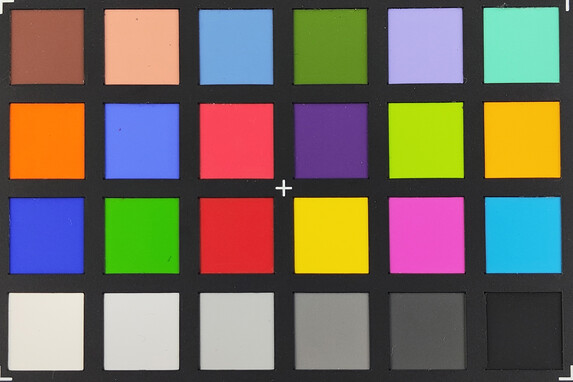

Scope of delivery and warranty - The Poco phone includes a power supply
The Poco F5's scope of delivery includes a modular 67-watt power supply, a data/charging cable, a protective case, a SIM tool and a short instruction manual including warranty information. Ex works, the phone has a screen protector pre-installed.
Xiaomi gives this phone a 12-month warranty.
Input devices & operation - The Xiaomi smartphone with FaceUnlock
The Poco F5 features an active fingerprint sensor which is located within the power button. It unlocks the mid-range phone reliably and with very good accuracy. It does take a short second for the phone's screen to illuminate fully. The phone also has a relatively insecure 2D facial recognition based on a FaceUnlock function which relies on the front-facing camera.
With a refresh rate of 240 Hz, the installed AMOLED dot panel reacts sensitively to touch inputs and refreshes up to 240 times a second - for example, when playing games - which leads to a low latency period after inputs. Inputs are implemented accurately on the 6.67-inch display.
Display - The Poco F5 with OLED
The device's 6.67-inch OLED display, which has a resolution of 2,400 x 1,080 pixels, has a maximum refresh rate of 120 Hz. Its refresh rate isn't adaptive, but the system can adapt it dynamically at 60 or 120 Hz if the user requests this. The HDR standards HLG, HDR10 as well as HDR10+ and Dolby Vision are all supported. The luminance measured by us is close to the manufacturer's specification of 1,000 nits, which means that HDR content is shown to its best advantage on the Poco F5's screen.
The screen's maximum brightness when depicting a pure white surface can reach 1,078 cd/m². When we added some darker areas to the screen during the APL18 test, the brightness levels stayed surprisingly similar (1,016 cd/m²). For comparison, a Samsung Galaxy A54 5G achieved peak brightness levels of 1,390 cd/m² during the APL18 test.
| |||||||||||||||||||||||||
Brightness Distribution: 93 %
Center on Battery: 1034 cd/m²
Contrast: ∞:1 (Black: 0 cd/m²)
ΔE ColorChecker Calman: 1.9 | ∀{0.5-29.43 Ø4.78}
ΔE Greyscale Calman: 2.7 | ∀{0.09-98 Ø5}
99.4% sRGB (Calman 2D)
Gamma: 2.24
CCT: 6917 K
| Xiaomi Poco F5 AMOLED, 2400x1080, 6.7" | Xiaomi Poco F4 AMOLED, 2400x1080, 6.7" | Realme 11 Pro AMOLED, 2412x1080, 6.7" | Samsung Galaxy A54 5G Super AMOLED, 2340x1080, 6.4" | Honor Magic5 Lite 5G AMOLED, 2400x1080, 6.7" | Xiaomi 13 Lite AMOLED, 2400x1080, 6.6" | |
|---|---|---|---|---|---|---|
| Screen | -16% | -7% | -1% | 9% | 11% | |
| Brightness middle (cd/m²) | 1034 | 917 -11% | 772 -25% | 940 -9% | 846 -18% | 905 -12% |
| Brightness (cd/m²) | 1033 | 923 -11% | 764 -26% | 935 -9% | 853 -17% | 904 -12% |
| Brightness Distribution (%) | 93 | 96 3% | 97 4% | 99 6% | 88 -5% | 99 6% |
| Black Level * (cd/m²) | ||||||
| Colorchecker dE 2000 * | 1.9 | 2 -5% | 1.72 9% | 2.4 -26% | 1.3 32% | 1 47% |
| Colorchecker dE 2000 max. * | 3.7 | 5.2 -41% | 3.83 -4% | 3.2 14% | 2.7 27% | 3 19% |
| Greyscale dE 2000 * | 2.7 | 3.5 -30% | 2.7 -0% | 2.2 19% | 1.7 37% | 2.2 19% |
| Gamma | 2.24 98% | 2.23 99% | 2.252 98% | 2.05 107% | 2.19 100% | 2.23 99% |
| CCT | 6917 94% | 6447 101% | 6621 98% | 6422 101% | 6570 99% | 6382 102% |
* ... smaller is better
As is on all OLED displays, the Poco F5's screen flickers over the whole brightness spectrum, too. During our measurements, we noted a constant frequency of 120 Hz. What sounds low at first can still be classified as easy on the eyes due to the flat amplitude curve.
The manufacturer itself claims the phone is capable of very high PWM dimming (1,920 Hz), which would be much more comfortable, especially for more sensitive users. We cannot conclusively clarify whether the cause for this difference is due to our measurement equipment or if this automatic dimming was just not active at the time of testing.
Screen Flickering / PWM (Pulse-Width Modulation)
| Screen flickering / PWM detected | 120 Hz | ||
The display backlight flickers at 120 Hz (worst case, e.g., utilizing PWM) . The frequency of 120 Hz is very low, so the flickering may cause eyestrain and headaches after extended use. In comparison: 53 % of all tested devices do not use PWM to dim the display. If PWM was detected, an average of 8111 (minimum: 5 - maximum: 343500) Hz was measured. | |||
Measurement series with fixed zoom level and different brightness settings
The Chinese manufacturer's mid-range phone features three color profiles in total and expanded settings which let you pick the color space, color temperature as well as set individual parameters including color saturation.
We analyzed the AMOLED panel's color calibration using the analysis software Calman and a photo spectrometer. Using the profile vivid, the P3 color space, which is larger compared to sRGB, is controlled and almost completely covered. We only noted small color deviations in our measurements and the measured Delta E values also denote low grayscale deviations.
Display Response Times
| ↔ Response Time Black to White | ||
|---|---|---|
| 1.25 ms ... rise ↗ and fall ↘ combined | ↗ 0.612 ms rise | |
| ↘ 0.6405 ms fall | ||
| The screen shows very fast response rates in our tests and should be very well suited for fast-paced gaming. In comparison, all tested devices range from 0.1 (minimum) to 240 (maximum) ms. » 6 % of all devices are better. This means that the measured response time is better than the average of all tested devices (20.2 ms). | ||
| ↔ Response Time 50% Grey to 80% Grey | ||
| 1.78 ms ... rise ↗ and fall ↘ combined | ↗ 0.8715 ms rise | |
| ↘ 0.913 ms fall | ||
| The screen shows very fast response rates in our tests and should be very well suited for fast-paced gaming. In comparison, all tested devices range from 0.165 (minimum) to 636 (maximum) ms. » 8 % of all devices are better. This means that the measured response time is better than the average of all tested devices (31.6 ms). | ||
The Poco F5 has great readability qualities outdoors - even direct sunlight is no problem for the AMOLED display. Only some reflections on the screen might get a bit annoying. The ambient light sensor reacts quickly to new lighting situations.
The screen's viewing-angle stability is very good. Even at flat angles, the display's brightness never gets any lower and its color depiction only gets a tiny bit cooler.
Performance - The Poco F5 with a Qualcomm SoC
Qualcomm promises massive performance increases within the Poco F5 with its Snapdragon 7+ Gen 2 compared to the phone's predecessor. The 4-nm chipset combines a Cortex X2 performance core (2.91 GHz) with three Cortex A710 cores (2.49 GHz) and four frugal Cortex A510 efficiency cores (1.8 GHz).
In our CPU benchmark package, the Poco F5 did considerably better than the Xiaomi 13 Lite which relies on the Snapdragon 7 Gen 1. The Snapdragon 7+ Gen 2 performed especially strongly in the Geekbench's multi-score. This means the Poco F5's results are on par with the Qualcomm Snapdragon 8+ Gen 1 within the Nothing Phone 2. During the AI and system benchmarks, there were no massive differences between the Poco phone and its mid-range competitors.
| UL Procyon AI Inference for Android - Overall Score NNAPI | |
| Xiaomi 13 Lite | |
| Realme 11 Pro | |
| Average of class Smartphone (3769 - 81594, n=139, last 2 years) | |
| Xiaomi Poco F4 | |
| Xiaomi Poco F5 | |
| Average Qualcomm Snapdragon 7+ Gen 2 (n=1) | |
| Samsung Galaxy A54 5G | |
| AImark - Score v3.x | |
| Xiaomi 13 Lite | |
| Average of class Smartphone (82 - 307528, n=125, last 2 years) | |
| Realme 11 Pro | |
| Xiaomi Poco F5 | |
| Average Qualcomm Snapdragon 7+ Gen 2 (n=1) | |
| Samsung Galaxy A54 5G | |
During the graphics tests, the installed Snapdragon SoC's Adreno 725 had to show its worth. In the GFXBench test (as well as in the 3DMark measurements), the Poco F5 performed 50 per cent better than the Poco F4 at times, which features the Adreno 650. Especially in the GFXBench test, the performance gain of an Adreno 730 compared to the Adreno 725 was quite low.
GFXBench (DX / GLBenchmark) 2.7: T-Rex Onscreen | 1920x1080 T-Rex Offscreen
GFXBench 3.0: on screen Manhattan Onscreen OGL | 1920x1080 1080p Manhattan Offscreen
GFXBench 3.1: on screen Manhattan ES 3.1 Onscreen | 1920x1080 Manhattan ES 3.1 Offscreen
GFXBench: on screen Car Chase Onscreen | 1920x1080 Car Chase Offscreen | on screen Aztec Ruins High Tier Onscreen | 2560x1440 Aztec Ruins High Tier Offscreen | on screen Aztec Ruins Normal Tier Onscreen | 1920x1080 Aztec Ruins Normal Tier Offscreen | 3840x2160 4K Aztec Ruins High Tier Offscreen
| 3DMark / Wild Life Extreme Unlimited | |
| Xiaomi Poco F5 | |
| Xiaomi Poco F4 | |
| Xiaomi 13 Lite | |
| Samsung Galaxy A54 5G | |
| Realme 11 Pro | |
| Honor Magic5 Lite 5G | |
| 3DMark / Wild Life Extreme | |
| Xiaomi Poco F5 | |
| Xiaomi Poco F4 | |
| Xiaomi 13 Lite | |
| Samsung Galaxy A54 5G | |
| Realme 11 Pro | |
| Honor Magic5 Lite 5G | |
| 3DMark / Wild Life Unlimited Score | |
| Xiaomi Poco F5 | |
| Xiaomi Poco F4 | |
| Xiaomi 13 Lite | |
| Samsung Galaxy A54 5G | |
| Realme 11 Pro | |
| Honor Magic5 Lite 5G | |
| 3DMark / Wild Life Score | |
| Xiaomi Poco F5 | |
| Xiaomi Poco F4 | |
| Xiaomi 13 Lite | |
| Samsung Galaxy A54 5G | |
| Realme 11 Pro | |
| Honor Magic5 Lite 5G | |
| GFXBench (DX / GLBenchmark) 2.7 / T-Rex Onscreen | |
| Xiaomi Poco F5 | |
| Xiaomi 13 Lite | |
| Samsung Galaxy A54 5G | |
| Xiaomi Poco F4 | |
| Realme 11 Pro | |
| GFXBench (DX / GLBenchmark) 2.7 / T-Rex Offscreen | |
| Xiaomi Poco F5 | |
| Xiaomi Poco F4 | |
| Xiaomi 13 Lite | |
| Samsung Galaxy A54 5G | |
| Realme 11 Pro | |
| GFXBench 3.0 / Manhattan Onscreen OGL | |
| Xiaomi Poco F5 | |
| Xiaomi 13 Lite | |
| Samsung Galaxy A54 5G | |
| Xiaomi Poco F4 | |
| Realme 11 Pro | |
| GFXBench 3.0 / 1080p Manhattan Offscreen | |
| Xiaomi Poco F5 | |
| Xiaomi Poco F4 | |
| Xiaomi 13 Lite | |
| Samsung Galaxy A54 5G | |
| Realme 11 Pro | |
| GFXBench 3.1 / Manhattan ES 3.1 Onscreen | |
| Xiaomi Poco F5 | |
| Xiaomi Poco F4 | |
| Xiaomi 13 Lite | |
| Samsung Galaxy A54 5G | |
| Realme 11 Pro | |
| GFXBench 3.1 / Manhattan ES 3.1 Offscreen | |
| Xiaomi Poco F5 | |
| Xiaomi Poco F4 | |
| Xiaomi 13 Lite | |
| Samsung Galaxy A54 5G | |
| Realme 11 Pro | |
| GFXBench / Car Chase Onscreen | |
| Xiaomi Poco F5 | |
| Xiaomi Poco F4 | |
| Xiaomi 13 Lite | |
| Samsung Galaxy A54 5G | |
| Realme 11 Pro | |
| GFXBench / Car Chase Offscreen | |
| Xiaomi Poco F5 | |
| Xiaomi Poco F4 | |
| Xiaomi 13 Lite | |
| Samsung Galaxy A54 5G | |
| Realme 11 Pro | |
| GFXBench / Aztec Ruins High Tier Onscreen | |
| Xiaomi Poco F5 | |
| Xiaomi Poco F4 | |
| Xiaomi 13 Lite | |
| Samsung Galaxy A54 5G | |
| Realme 11 Pro | |
| Honor Magic5 Lite 5G | |
| GFXBench / Aztec Ruins High Tier Offscreen | |
| Xiaomi Poco F5 | |
| Xiaomi Poco F4 | |
| Xiaomi 13 Lite | |
| Samsung Galaxy A54 5G | |
| Realme 11 Pro | |
| Honor Magic5 Lite 5G | |
| GFXBench / Aztec Ruins Normal Tier Onscreen | |
| Xiaomi Poco F5 | |
| Xiaomi Poco F4 | |
| Xiaomi 13 Lite | |
| Samsung Galaxy A54 5G | |
| Realme 11 Pro | |
| Honor Magic5 Lite 5G | |
| GFXBench / Aztec Ruins Normal Tier Offscreen | |
| Xiaomi Poco F4 | |
| Xiaomi 13 Lite | |
| Xiaomi Poco F5 | |
| Samsung Galaxy A54 5G | |
| Realme 11 Pro | |
| Honor Magic5 Lite 5G | |
| GFXBench / 4K Aztec Ruins High Tier Offscreen | |
| Xiaomi Poco F5 | |
| Xiaomi Poco F4 | |
| Xiaomi 13 Lite | |
| Samsung Galaxy A54 5G | |
| Realme 11 Pro | |
| Honor Magic5 Lite 5G | |
When it comes to browser speed, the Xiaomi phone also didn't show any weaknesses. Websites were loaded quickly and you could scroll through them smoothly. It didn't dominate quite as much within the benchmarks, but even here, the Poco F5 managed to come out on top.
| Jetstream 2 - 2.0 Total Score | |
| Average of class Smartphone (23.8 - 387, n=152, last 2 years) | |
| Average Qualcomm Snapdragon 7+ Gen 2 (n=1) | |
| Xiaomi Poco F5 (Chrome 116) | |
| Xiaomi Poco F4 (Edge 105) | |
| Samsung Galaxy A54 5G (Chrome 112) | |
| Realme 11 Pro (Chrome 115) | |
| Xiaomi 13 Lite (Chrome 111.0.5563.115) | |
| Speedometer 2.0 - Result 2.0 | |
| Average of class Smartphone (15.2 - 643, n=126, last 2 years) | |
| Xiaomi Poco F5 (Chrome 116) | |
| Average Qualcomm Snapdragon 7+ Gen 2 (n=1) | |
| Realme 11 Pro (Chrome 115) | |
| Samsung Galaxy A54 5G (Chrome 112) | |
| Xiaomi 13 Lite (Chrome 111.0.5563.115) | |
| Xiaomi Poco F4 (Edge 105) | |
| WebXPRT 4 - Overall | |
| Average of class Smartphone (27 - 306, n=148, last 2 years) | |
| Xiaomi Poco F5 (Chrome 116) | |
| Average Qualcomm Snapdragon 7+ Gen 2 (n=1) | |
| Samsung Galaxy A54 5G (Chrome 112) | |
| Xiaomi 13 Lite (Chrome 111.0.5563.115) | |
| Realme 11 Pro (Chrome 115) | |
| Xiaomi Poco F4 (Chrome 103) | |
| WebXPRT 3 - Overall | |
| Average of class Smartphone (38 - 380, n=34, last 2 years) | |
| Xiaomi Poco F5 (Chrome 116) | |
| Average Qualcomm Snapdragon 7+ Gen 2 (n=1) | |
| Samsung Galaxy A54 5G (Chrome 112) | |
| Xiaomi 13 Lite (Chrome 111.0.5563.115) | |
| Xiaomi Poco F4 (chrome 103) | |
| Realme 11 Pro (Chrome 115) | |
| Octane V2 - Total Score | |
| Average of class Smartphone (2228 - 121337, n=200, last 2 years) | |
| Xiaomi Poco F5 (Chrome 116) | |
| Average Qualcomm Snapdragon 7+ Gen 2 (n=1) | |
| Xiaomi Poco F4 (Edge 105) | |
| Samsung Galaxy A54 5G (Chrome 112) | |
| Realme 11 Pro (Chrome 115) | |
| Xiaomi 13 Lite (Chrome 111.0.5563.115) | |
| Honor Magic5 Lite 5G (Chrome 112) | |
| Mozilla Kraken 1.1 - Total | |
| Xiaomi Poco F4 (chrome 103) | |
| Realme 11 Pro (Chrome 115) | |
| Xiaomi 13 Lite (Chrome 111.0.5563.115) | |
| Samsung Galaxy A54 5G (Chrome 112) | |
| Average of class Smartphone (257 - 28190, n=155, last 2 years) | |
| Xiaomi Poco F5 (Chrome 116) | |
| Average Qualcomm Snapdragon 7+ Gen 2 (n=1) | |
* ... smaller is better
In terms of storage speed, the Poco F5's UFS storage offers great performance. Especially when writing and reading small data blocks, the scores of the AndroBench test were impressive and twice as high compared to the Poco F4.
| Xiaomi Poco F5 | Xiaomi Poco F4 | Realme 11 Pro | Samsung Galaxy A54 5G | Honor Magic5 Lite 5G | Xiaomi 13 Lite | Average 256 GB UFS 3.1 Flash | Average of class Smartphone | |
|---|---|---|---|---|---|---|---|---|
| AndroBench 3-5 | -49% | -31% | -69% | -69% | -41% | -24% | -7% | |
| Sequential Read 256KB (MB/s) | 1798.37 | 1371.56 -24% | 1818 1% | 528.32 -71% | 486.17 -73% | 1001.82 -44% | 1757 ? -2% | 2222 ? 24% |
| Sequential Write 256KB (MB/s) | 1736.41 | 701.06 -60% | 1233.6 -29% | 335.39 -81% | 420.44 -76% | 871.96 -50% | 1204 ? -31% | 1841 ? 6% |
| Random Read 4KB (MB/s) | 389.37 | 183.61 -53% | 233.6 -40% | 236.23 -39% | 171.13 -56% | 277.33 -29% | 287 ? -26% | 294 ? -24% |
| Random Write 4KB (MB/s) | 498.93 | 200.41 -60% | 226.6 -55% | 70.52 -86% | 149.12 -70% | 301.41 -40% | 318 ? -36% | 334 ? -33% |
Games - The Xiaomi smartphone won't manage 100 fps
After our GPU benchmarks, the installed Adreno 725 (along with its 8 GB RAM) has to show whether you can play any demanding games on the Poco F5 and whether it is suitable for HFR gaming. We used the app from GameBench to measure the frame rate during our measurements.
When running PUBG Mobile with high detail settings (UHD), we noted a consistent frame rate of 40 fps. If we reduced it to HD, the Qualcomm graphics unit managed an even 60 frames per second. Even switching to the 90-fps setting with low graphic details didn't raise the frame rate at all. Slightly less demanding games, such as Armajet, also don't make use of the OLED panel's full 120 Hz. After a short while, the frame rate sinks to considerably below 60 fps.
We took a look at the graphically demanding fantasy-action-role-playing game Genshin Impact as the third and final game in this test. At high detail settings, we measured 30 fps - with reduced graphics, the Poco F5 even managed 60 fps.
Emissions - The Poco F5 charges fairly quickly
Temperature
In idle mode, the Poco F5's surface temperatures were inconspicuous - but under permanent load, we measured peaks of almost 46 °C. However, this was also due to the very demanding Burnout benchmark. A Galaxy A54 may have been quite a bit cooler during the test, for example, but another app (Stability Test) made it sweat a bit more. An exact comparison of the Poco F5's values with older tests is therefore not possible.
In the 3DMark's Wild Life Stress tests, we checked whether the heat inside the phone is able to be dissipated sufficiently well and whether the case is cooled sufficiently. With a maximum throttling of 15 per cent, the Xiaomi phone performed relatively consistently despite a slight reduction in performance.
(±) The maximum temperature on the upper side is 44.8 °C / 113 F, compared to the average of 35.2 °C / 95 F, ranging from 21.9 to 247 °C for the class Smartphone.
(-) The bottom heats up to a maximum of 45.9 °C / 115 F, compared to the average of 34 °C / 93 F
(+) In idle usage, the average temperature for the upper side is 28.7 °C / 84 F, compared to the device average of 32.9 °C / 91 F.
3DMark Wild Life Stress Test
| 3DMark | |
| Wild Life Stress Test Stability | |
| Honor Magic5 Lite 5G | |
| Xiaomi 13 Lite | |
| Realme 11 Pro | |
| Samsung Galaxy A54 5G | |
| Xiaomi Poco F4 | |
| Xiaomi Poco F5 | |
| Wild Life Extreme Stress Test | |
| Xiaomi Poco F5 | |
| Xiaomi 13 Lite | |
| Realme 11 Pro | |
| Samsung Galaxy A54 5G | |
| Honor Magic5 Lite 5G | |
| Xiaomi Poco F4 | |
Speakers
The Poco F5 relies on a dual speaker system that provides a sufficiently loud sound besides the stereo feeling - we measured a maximum volume of 91 dB. However, the mid-range phone cannot provide real depth with present basses, but the trebles are reproduced linearly. Our measurements also showed a solid, ascending frequency response for the mids.
If you want to use a wired audio output, you can use the 3.5-millimeter jack for this. The noise levels are within a good range with an SNR value of about 80 dBFS. Modern Bluetooth 5.3 is available wirelessly. The Poco phone uses a wide range of supported codecs (SBC, AAC, aptX, aptX HD, aptX Adaptive, aptX TWS+, LDAC and LHDC V5).
Xiaomi Poco F5 audio analysis
(+) | speakers can play relatively loud (90.6 dB)
Bass 100 - 315 Hz
(-) | nearly no bass - on average 25.5% lower than median
(±) | linearity of bass is average (7.4% delta to prev. frequency)
Mids 400 - 2000 Hz
(±) | reduced mids - on average 6.1% lower than median
(+) | mids are linear (5.4% delta to prev. frequency)
Highs 2 - 16 kHz
(±) | higher highs - on average 5.6% higher than median
(+) | highs are linear (5.3% delta to prev. frequency)
Overall 100 - 16.000 Hz
(±) | linearity of overall sound is average (19.2% difference to median)
Compared to same class
» 25% of all tested devices in this class were better, 9% similar, 66% worse
» The best had a delta of 11%, average was 35%, worst was 134%
Compared to all devices tested
» 45% of all tested devices were better, 7% similar, 47% worse
» The best had a delta of 4%, average was 24%, worst was 134%
Honor Magic5 Lite 5G audio analysis
(+) | speakers can play relatively loud (90.7 dB)
Bass 100 - 315 Hz
(-) | nearly no bass - on average 29.1% lower than median
(+) | bass is linear (6.1% delta to prev. frequency)
Mids 400 - 2000 Hz
(+) | balanced mids - only 3.9% away from median
(+) | mids are linear (4.7% delta to prev. frequency)
Highs 2 - 16 kHz
(±) | higher highs - on average 7.1% higher than median
(+) | highs are linear (6.2% delta to prev. frequency)
Overall 100 - 16.000 Hz
(±) | linearity of overall sound is average (20.6% difference to median)
Compared to same class
» 35% of all tested devices in this class were better, 9% similar, 56% worse
» The best had a delta of 11%, average was 35%, worst was 134%
Compared to all devices tested
» 54% of all tested devices were better, 8% similar, 38% worse
» The best had a delta of 4%, average was 24%, worst was 134%
Battery life - The Xiaomi phone with a better battery
Power consumption
Although the Poco F5 is lighter than its predecessor, the battery's capacity is now 500 mAh bigger. The phone's 5,000-mAh battery, which can be charged at a maximum of 67 watts via a cable, takes about 48 minutes to be fully charged from zero. Thankfully, a sufficiently fast charger is included within the device's scope of delivery. Wireless charging and reverse wireless charging are not supported.
The Poco F5 has a very low idle power consumption of around 1 watt. The Snapdragon 7+ Gen 2 uses quite a bit more power under load, but even so, you have to take into account the Burnout benchmark when comparing it to the competition. An HTC U23 Pro with the Snapdragon 7 Gen 1 also used peaks of 11 watts in our new measurement setup but still, the Poco F5 seems to suffer from quite a high consumption under load.
| Off / Standby | |
| Idle | |
| Load |
|
Key:
min: | |
| Xiaomi Poco F5 5000 mAh | Xiaomi Poco F4 4500 mAh | Realme 11 Pro 5000 mAh | Samsung Galaxy A54 5G 5000 mAh | Xiaomi 13 Lite 4500 mAh | Average Qualcomm Snapdragon 7+ Gen 2 | Average of class Smartphone | |
|---|---|---|---|---|---|---|---|
| Power Consumption | 15% | 10% | 2% | 7% | 0% | -6% | |
| Idle Minimum * (Watt) | 0.89 | 0.8 10% | 0.9 -1% | 0.75 16% | 0.74 17% | 0.89 ? -0% | 0.848 ? 5% |
| Idle Average * (Watt) | 1.05 | 1.29 -23% | 1.3 -24% | 1.51 -44% | 1.56 -49% | 1.05 ? -0% | 1.434 ? -37% |
| Idle Maximum * (Watt) | 1.08 | 1.38 -28% | 1.7 -57% | 1.62 -50% | 1.59 -47% | 1.08 ? -0% | 1.618 ? -50% |
| Load Average * (Watt) | 10.86 | 3.78 65% | 3.5 68% | 4.91 55% | 3.33 69% | 10.9 ? -0% | 7.01 ? 35% |
| Load Maximum * (Watt) | 13.49 | 6.71 50% | 5 63% | 8.93 34% | 7.59 44% | 13.5 ? -0% | 11.3 ? 16% |
* ... smaller is better
Power consumption: Geekbench (150 cd/m²)
Power consumption: GFXBench (150 cd/m²)
Runtimes
In our real-world battery tests, which are performed with an adjusted display brightness of 150 cd/m² and are therefore very well comparable, the Poco F5 delivered strong runtimes at a fixed 120 Hz refresh rate.
The mid-range phone managed about 17 hours in the WLAN test, and even two hours more were possible during endless video playback with the WLAN module disabled. Compared to its predecessor, this results in a rich runtime increase of 25 per cent.
| Xiaomi Poco F5 5000 mAh | Xiaomi Poco F4 4500 mAh | Realme 11 Pro 5000 mAh | Samsung Galaxy A54 5G 5000 mAh | Honor Magic5 Lite 5G 5100 mAh | Xiaomi 13 Lite 4500 mAh | |
|---|---|---|---|---|---|---|
| Battery runtime | -20% | 22% | 26% | -20% | 13% | |
| Reader / Idle (h) | 22.1 | 22.4 1% | 43.2 95% | 43.2 95% | 37.3 69% | |
| H.264 (h) | 18.7 | 15.5 -17% | 20.4 9% | 25.1 34% | 19.8 6% | |
| WiFi v1.3 (h) | 16.9 | 11.1 -34% | 13.3 -21% | 15.7 -7% | 13.6 -20% | 13.7 -19% |
| Load (h) | 5.7 | 4.1 -28% | 5.9 4% | 4.7 -18% | 5.4 -5% |
Pros
Cons
Verdict on the Xiaomi Poco F5
The Poco F5 is a very interesting choice when it comes to phones below US$500. Thanks to its Snapdragon 7+ Gen 2, the phone offers considerably better performance compared to similarly priced mid-range phones, such as the Samsung Galaxy A54 5G or the Honor Magic5 Lite.
Aside from its powerful Qualcomm SoC, the Xiaomi phone also impresses with its great range of features (WiFi 6E, 3.5-mm jack, fat charging, ...), bright 120-Hz AMOLED panel with high color space coverage, as well as long runtimes. Additionally, hardly any other phones within this price range offer such an extensive scope of delivery as the Poco F5. When it comes to its camera package, the Poco F5 delivers good performance in daylight – but not much more than that. The main camera may have access to OIS, but photography is by no means one of the Xiaomi phone's strengths.
The Xiaomi Poco F5 combines good performance and strong hardware in a slim, lightweight case.
The phone's uncertain update delivery slightly clouds an otherwise great total package. Here, Samsung's A-series is much more future-proof, as it has a five-year update guarantee. It might also be worth taking a look at the Google Pixel 7a which also features IP67 certification, wireless charging and a better camera for around US$450.
Price and availability
At the time of testing, the Poco F5 can be found from US$391.50 on Amazon.
Xiaomi Poco F5
- 09/18/2023 v7 (old)
Marcus Herbrich
Transparency
The selection of devices to be reviewed is made by our editorial team. The test sample was provided to the author as a loan by the manufacturer or retailer for the purpose of this review. The lender had no influence on this review, nor did the manufacturer receive a copy of this review before publication. There was no obligation to publish this review. As an independent media company, Notebookcheck is not subjected to the authority of manufacturers, retailers or publishers.
This is how Notebookcheck is testing
Every year, Notebookcheck independently reviews hundreds of laptops and smartphones using standardized procedures to ensure that all results are comparable. We have continuously developed our test methods for around 20 years and set industry standards in the process. In our test labs, high-quality measuring equipment is utilized by experienced technicians and editors. These tests involve a multi-stage validation process. Our complex rating system is based on hundreds of well-founded measurements and benchmarks, which maintains objectivity. Further information on our test methods can be found here.




